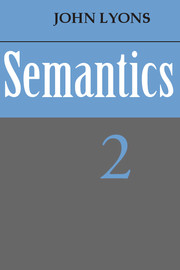Book contents
- Frontmatter
- Contents
- Figures
- Typographical conventions
- Preface
- 10 Semantics and grammar I
- 11 Semantics and grammar II
- 12 Semantics and grammar III
- 13 The Lexicon
- 14 Context, style and culture
- 15 Deixis, space and time
- 16 Mood and illocutionary force
- 17 Modality
- Bibliography
- Index of subjects
- Index of personal names
10 - Semantics and grammar I
Published online by Cambridge University Press: 05 June 2012
- Frontmatter
- Contents
- Figures
- Typographical conventions
- Preface
- 10 Semantics and grammar I
- 11 Semantics and grammar II
- 12 Semantics and grammar III
- 13 The Lexicon
- 14 Context, style and culture
- 15 Deixis, space and time
- 16 Mood and illocutionary force
- 17 Modality
- Bibliography
- Index of subjects
- Index of personal names
Summary
Levels of analysis
Most linguists distinguish at least three levels of structure in their analysis of sentences: the phonological, the syntactic and the semantic. To these three they may or may not add morphology to serve as a bridge between the syntax and the phonology in particular languages.
Looked at from the point of view of its phonological structure, every sentence may be represented as a sequence of phonemes with a certain prosodic contour superimposed upon it (cf. 3.1). The phonemes of a language are conventionally represented by means of letters enclosed within a pair of oblique strokes. For example, there is in English a phoneme /b/ which occurs in the initial position of the forms bed, bread, boil, etc., and is pronounced as a bilabial, voiced, non-nasal stop; and this phoneme, like all the other phonemes of English, has a characteristic distribution throughout the word-forms of the language. It is part of the phonologist's job to list, for the language that he is describing, all the phonemes that occur in that language and to specify the principles which determine their co-occurrence, or combination, in actual and potential word-forms. He will tell us, for example, that the combination of /b/ with /n/ is impossible in the first two positions of English word-forms; and he may account for this in terms of the more general principle that stop consonants do not precede nasal consonants in English at the beginning of a syllable.
- Type
- Chapter
- Information
- Semantics , pp. 373 - 422Publisher: Cambridge University PressPrint publication year: 1977



